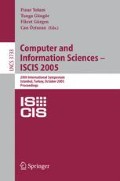Abstract
Dense subgraphs of sparse graphs (communities), which appear in most real-world complex networks, play an important role in many contexts. Computing them however is generally expensive. We propose here a measure of similarities between vertices based on random walks which has several important advantages: it captures well the community structure in a network, it can be computed efficiently, it works at various scales, and it can be used in an agglomerative algorithm to compute efficiently the community structure of a network. We propose such an algorithm which runs in time O(mn 2) and space O(n 2) in the worst case, and in time O(n 2log n) and space O(n 2) in most real-world cases (n and m are respectively the number of vertices and edges in the input graph).
Access this chapter
Tax calculation will be finalised at checkout
Purchases are for personal use only
Preview
Unable to display preview. Download preview PDF.
References
Wasserman, S., Faust, K.: Social network analysis. Cambridge University Press, Cambridge (1994)
Strogatz, S.H.: Exploring complex networks. Nature 410, 268–276 (2001)
Albert, R., Barabási, A.L.: Statistical mechanics of complex networks. Reviews of Modern Physics 74, 47 (2002)
Newman, M.E.J.: The structure and function of complex networks. SIAM REVIEW 45, 167 (2003)
Dorogovtsev, S., Mendes, J.: Evolution of Networks: From Biological Nets to the Internet and WWW. Oxford University Press, Oxford (2003)
Clauset, A., Newman, M.E.J., Moore, C.: Finding community structure in very large networks. Physical Review E 70 (2004) 066111
Pothen, A., Simon, H.D., Liou, K.P.: Partitioning sparse matrices with eigenvectors of graphs. SIAM J. Matrix Anal. Appl. 11, 430–452 (1990)
Kernighan, B.W., Lin, S.: An efficient heuristic procedure for partitioning graphs. Bell System Technical Journal 49, 291–308 (1970)
Girvan, M., Newman, M.E.J.: Community structure in social and biological networks. PNAS 99, 7821–7826 (2002)
Newman, M.E.J., Girvan, M.: Finding and evaluating community structure in networks. Physical Review E 69 (2004) 026113
Radicchi, F., Castellano, C., Cecconi, F., Loreto, V., Parisi, D.: Defining and identifying communities in networks. PNAS 101, 2658–2663 (2004)
Fortunato, S., Latora, V., Marchiori, M.: Method to find community structures based on information centrality. Physical Review E 70, 56104 (2004)
Newman, M.E.J.: Fast algorithm for detecting community structure in networks. Physical Review E 69, 66133 (2004)
Donetti, L., Muñoz, M.A.: Detecting network communities: a new systematic and efficient algorithm. Journal of Statistical Mechanics 2004, 10012 (2004)
Wu, F., Huberman, B.A.: Finding communities in linear time: A physics approach. The European Physical Journal B 38, 331–338 (2004)
Reichardt, J., Bornholdt, S.: Detecting fuzzy community structures in complex networks with a potts model. Physical Review Letters 93 (2004) 218701
Bagrow, J., Bollt, E.: A local method for detecting communities. Physical Review E (2005) (to appear)
Duch, J., Arenas, A.: Community detection in complex networks using extremal optimization. arXiv:cond-mat/0501368 (2005)
Gaume, B.: Balades aléatoires dans les petits mondes lexicaux. I3 Information Interaction Intelligence 4 (2004)
Fouss, F., Pirotte, A., Saerens, M.: A novel way of computing dissimilarities between nodes of a graph, with application to collaborative filtering. In: Workshop on Statistical Approaches for Web Mining (SAWM), Pisa, pp. 26–37 (2004)
Zhou, H., Lipowsky, R.: Network brownian motion: A new method to measure vertex-vertex proximity and to identify communities and subcommunities. In: Bubak, M., van Albada, G.D., Sloot, P.M.A., Dongarra, J. (eds.) ICCS 2004. LNCS, vol. 3038, pp. 1062–1069. Springer, Heidelberg (2004)
van Dongen, S.: Graph Clustering by Flow Simulation. PhD thesis, University of Utrecht (2000)
Lovász, L.: Random walks on graphs: a survey. In: Combinatorics, Paul Erdős is eighty, Budapest. Bolyai Soc. Math. Stud. János Bolyai Math. Soc., vol. 2, pp. 353–397 (1996); (Keszthely, 1993)
Simonsen, I., Eriksen, K.A., Maslov, S., Sneppen, K.: Diffusion on complex networks: a way to probe their large-scale topological structures. Physica A: Statistical Mechanics and its Applications 336, 163–173 (2004)
Schulman, L.S., Gaveau, B.: Coarse grains: The emergence of space and order. Foundations of Physics 31, 713–731 (2001)
Gaveau, B., Lesne, A., Schulman, L.S.: Spectral signatures of hierarchical relaxation. Physics Letters A 258, 222–228 (1999)
Ward, J.H.: Hierarchical grouping to optimize an objective function. Journal of the American Statistical Association 58, 236–244 (1963)
Jambu, M., Lebeaux, M.: Cluster analysis and data analysis. North Holland Publishing, Amsterdam (1983)
Pons, P.: http://liafa.jussieu.fr/~pons/
Author information
Authors and Affiliations
Editor information
Editors and Affiliations
Rights and permissions
Copyright information
© 2005 Springer-Verlag Berlin Heidelberg
About this paper
Cite this paper
Pons, P., Latapy, M. (2005). Computing Communities in Large Networks Using Random Walks. In: Yolum, p., Güngör, T., Gürgen, F., Özturan, C. (eds) Computer and Information Sciences - ISCIS 2005. ISCIS 2005. Lecture Notes in Computer Science, vol 3733. Springer, Berlin, Heidelberg. https://doi.org/10.1007/11569596_31
Download citation
DOI: https://doi.org/10.1007/11569596_31
Publisher Name: Springer, Berlin, Heidelberg
Print ISBN: 978-3-540-29414-6
Online ISBN: 978-3-540-32085-2
eBook Packages: Computer ScienceComputer Science (R0)

